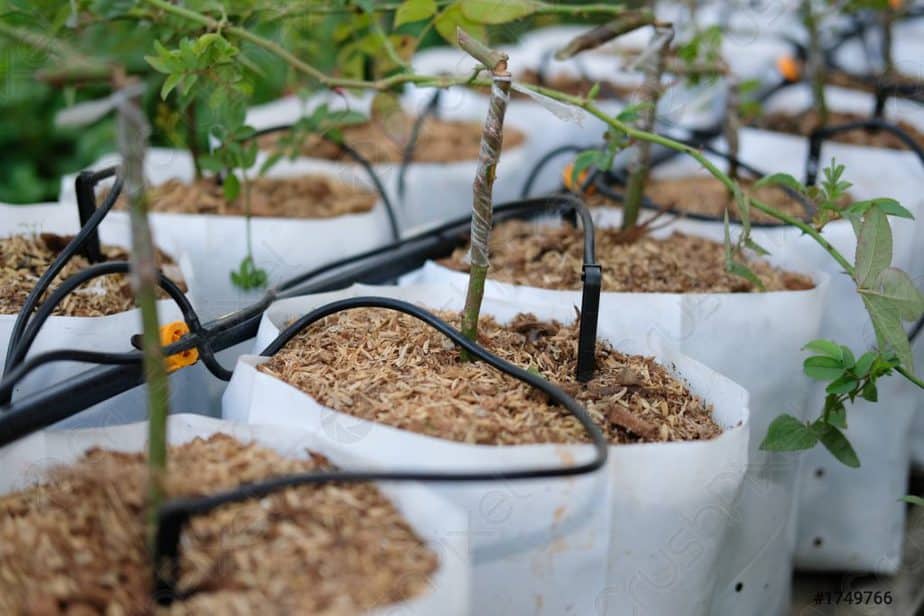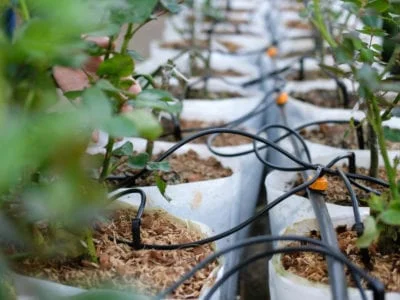Soil Moisture Control
Automatic Drip Irrigation is a valuable tool for accurate soil moisture control in highly specialized greenhouse vegetable production. Total automation of drip irrigation offers a simple, precise method for sensing soil moisture and applying water. Management time savings and the removal of human error in estimating and adjusting available soil moisture levels enable skilled growers to maximize net profits.
Available soil moisture is an important limiting factor in growth and productivity. Greenhouse vegetable growers commonly estimate the availability of soil moisture by plant and soil appearance. Slight wilting of succulent terminal leaves indicates water stress in plants. Growers squeeze handfuls of soil taken from near the surface at several locations in the greenhouse. Soil that does not stay compressed in a tight ball is considered too dry.
Water deficiency can be detrimental to plants before visible wilting occurs. Slowed growth rate, lighter weight fruit and, in tomato, blossom end rot often follow slight water deficiencies. Replacing traditional methods of estimating available soil moisture with a more accurate method is necessary to maintain optimum soil moisture levels.
Conventional irrigation methods usually wet plant’s lower leaves and stems. The entire soil surface is saturated and often stays wet long after irrigation is completed. Such conditions promote infection by grey mould-rot (Botrytis) and leaf mould fungi.
Most greenhouse vegetable plants remove large amounts of water from soil at the 10″ to 12″ depth. An accurate estimate of available soil moisture at this important depth cannot be made by testing the top few inches of soil. In a greenhouse on a sunny day, transpiration and evaporation can occur so rapidly that excessive water loss can cause plant damage before sufficient water can be applied to correct moisture stress. Water stress, no matter how slight, will cause a significant reduction in harvest weight.
Drip irrigation is a slow water delivery system in which water can be applied, drop by drop, to the soil surface near the base of the plant. A properly designed automatic drip irrigation system can remove much guessing about when to irrigate and how much water to apply. Water is applied whenever the sensor indicates a sub-optimum soil moisture level.
Using automatic drip irrigation systems, skilled greenhouse managers can:
- Apply correct water amounts precisely when required to maintain optimum available soil moisture in the root zone.
- Reduce management time required for observing plant water needs and manually controlling irrigation systems.
- Keep leaf surfaces and stems drier because water drips directly on the soil instead of spraying in the air.
- Prevent water puddling and splashing by applying water no faster than it will percolate into the soil.
- Reduce incidence of leaf mold, gray mold-rot and other foliage diseases.
- Reduce evaporation losses and fruit deterioration by keeping more soil surface dry.
- Increase production if other factors are not limiting.

Planning a Drip Irrigation System
Uniform water application, operating convenience and minimum cost are important objectives in planning a greenhouse drip irrigation system. Carefully study this section’s ideas on achieving these objectives before selecting drip irrigation system components.
Divide the total greenhouse area into equal or similar sections or into individual houses. Plan irrigation systems so that each house or section can be irrigated independently. Plan total irrigation systems in conjunction with other greenhouse water needs to prevent exceeding water supplies.
The total amount of water available for all greenhouse uses, often described in gallons per minute, is a useful figure. Using a portable water meter, the well or other supply source usually can be measured. Water delivery rate from small wells often is determined by measuring the time required (in seconds or minutes) to fill a container of known volume. When greenhouse water requirements exceed the well delivery rate, a storage tank can increase the quantity available during the peak usage.
Water Requirements
Drip irrigation requires less water than lay-flat perforated hose, flooding or other frequently used water distribution procedures. Plan irrigation piping for each separately irrigated greenhouse section or individual greenhouse to distribute 1.6 to 2.4 gallons per minute for each 1,000 square feet. This is 8 to 12 gallons per minute for each 5,000 square feet of growing area. Less water may not fully pressurize the irrigation system piping, causing uneven water application. Uneven water distribution often creates dry or over wet areas.
Soil texture controls the rate at which water can be absorbed by the soil. To prevent puddling and runoff, plan lower water delivery rates for heavy clay soils with characteristic lower water intake rates. Be careful to plan the water delivery rate to be no greater than the soil water intake rate.
By: Roland E. Roberts. Extension Irrigation Specialist and Vegetable Specialist

